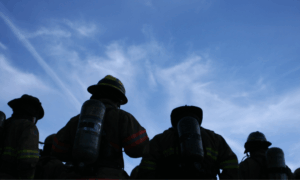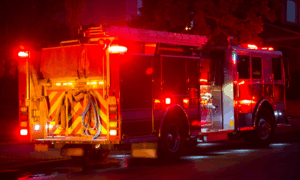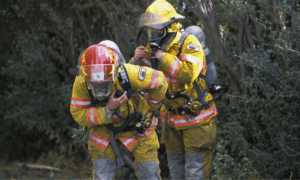Roughly two out of three workers say they are worried about running out of money in retirement.1 That is the general population. For firefighters who often retire in their early fifties, that worry tends to hit even harder. You step out of the station, your pension kicks on, markets start doing their roller coaster routine, and suddenly the question becomes simple yet brutal.
Can you keep a steady paycheck when the market does not cooperate?
Many firefighters retire earlier than most workers. One 2024 analysis put the typical firefighter retirement age around 52.3 That means you could be staring at 30 or even 40 years of retirement paychecks. Your pension might be solid, but your 457 plan, IRAs, and other investments will still rise and fall with the market. That is where retirement spending guardrails come in. They give you a simple, rule based way to adjust your withdrawals so your income stays controlled even when markets look like a three alarm call.
Before we dive into the nuts and bolts of guardrails, it helps to look at why firefighters feel the risk more than most retirees.
Why Retirement Feels Risky Even When You Have a Pension
Firefighters often have something a lot of private sector workers would love: a defined benefit pension. In many states, that pension is based on a percentage of your highest earning years. A common formula is around 2 percent per year of service, multiplied by the average of your top three years of pay.4 Work 25 or 30 years and that can replace a big chunk of your final salary.
Take one example from Indiana. A firefighter there can earn a pension equal to 50 percent of a first class firefighter’s salary after 20 years, and can build toward roughly three quarters of pay by staying longer.4 That is strong income, but it usually does not replace your entire paycheck, and in many plans there is little or no Social Security on top of it. Your pension is your base. Your savings have to cover the rest.
On top of that, early retirement stretches the timeline. A firefighter who leaves the job around 52 could spend a decade or more in the “gap” years before Social Security and Medicare show up. Market crashes that hit in those years matter a lot. They hit at the exact moment when your body is done with fireground work but your money needs to keep working harder than ever.
That combination sets up the real problem. You have steady pension checks, but you also have a pot of money in a 457 or rollover IRA that is exposed to markets. If you pull too much from that pot when markets are down, you risk draining it. If you never touch it because you are scared, you end up living tighter than you need to. Guardrails are built to solve exactly that tension, so let us lay out what they are.
What Are Retirement Spending Guardrails?
Most people have heard some version of the “4 percent rule.” The idea is that you can withdraw around 4 percent of your savings in the first year of retirement, adjust that dollar amount for inflation each year, and have a decent chance of making your money last around 30 years.2 Researchers and planners still argue over the exact number, but the big problem is that real life is not that smooth. Markets do not rise in a straight line and your spending does not either.
Guardrail strategies step in here. Instead of pretending you can lock in one withdrawal number forever, guardrails set a target withdrawal and then build a “do not cross” line above and below it. If your withdrawal rate drifts up because markets fall, you trim spending by a set percentage. If your withdrawal rate drifts down because markets have been kind, you can give yourself a raise. That is it. Rules you can actually follow.
Some of the best known research on this came from Jonathan Guyton and William Klinger, who tested “decision rules” that let retirees start with a higher withdrawal rate as long as they agreed to cut spending when certain guardrails were hit.5 Later work on guardrails found similar results. You can usually start a bit higher than a flat 4 percent rule if you are willing to make occasional adjustments when the numbers tell you to.6

How Guardrails Keep Withdrawal Rates on Track
The black dot represents your withdrawal rate drifting as markets move. Hitting the red lines triggers pre-planned adjustments.
Once you see guardrails as “rules to adjust spending when your withdrawal rate drifts,” it becomes easier to plug them into a firefighter’s actual income picture and not just a textbook example.
How Guardrails Fit A Firefighter Paycheck
Your retirement income usually has three layers.
First layer: pension. Depending on your state or federal system, you may see something like 50 to 70 percent of your final salary from your pension if you do a full career.34 Some systems have cost of living adjustments, some do not. Either way, this is your “floor.” It is not tied to the S&P 500. It does not swing around with headlines.
Second layer: savings and investments. This is your 457 plan, any 401(k) or 403(b), IRAs, brokerage accounts, and any rollovers you do when you leave the job. That money probably holds stocks and bonds. It has growth potential and risk. Guardrails mostly live here.
Third layer: other protected income and insurance. That could be Social Security, a spouse’s pension, or private income guarantees you might already own. These can either tighten or loosen how aggressive your guardrails can be, because they change how much of your basic budget is truly at risk in the market.

Visualize Income Variability
Use the slider to see how market conditions affect the "Guardrail" layer of your income stack.
Guardrails focus on the part of your spending that depends on the second and third layers. The math starts with a simple reality check. Let us say you are a retired captain with a pension that covers 60 percent of your old take home pay. Your actual retirement budget target is around 80 percent of that old paycheck. That means roughly one quarter of your income needs to come from savings.
You look at your 457 and IRAs and see a combined balance of 700,000 dollars. In the first year, you decide to withdraw 4.5 percent from those accounts, or 31,500 dollars, to close the gap between pension and desired lifestyle. That 4.5 percent is your starting withdrawal rate. You then set guardrails around that number. For example, you might decide that if your withdrawal rate climbs to 6 percent after a market drop, you will trim withdrawals by 10 percent until things stabilize. If your withdrawal rate falls to 3 percent after years of strong returns, you will give yourself a 10 percent raise in spending.
This approach keeps the pension steady and uses flexible spending from your savings as the shock absorber.
Your pension and core essential expenses line up, and the part of your budget funded by investments breathes a little. You tighten that part when the market is ugly and loosen it when the portfolio is fat and happy.
Building Your Own Guardrail Plan
You do not need a PhD to build a workable guardrail plan. You do need a clear view of your pension, your savings, and your actual spending. Here is a practical way to set it up.
Step 1: Nail down your floor. Start with your pension estimate, survivor benefit choice, and any Social Security or extra income you expect. Many state and federal guides walk you through the pension formulas and options, and firefighter focused resources show typical ranges for benefits and caps.34 The goal is to know exactly how much predictable income you have before touching your 457 or IRA.
Step 2: Separate essential and flexible spending. Essentials are the bills that keep you housed, fed, insured, and able to live with dignity. Flexible spending is travel, toys, nicer vehicles, gifts, and the “we earned this” bucket. Guardrails mostly act on the flexible bucket. In a rough year you might delay a new truck or shorten a vacation week instead of messing with mortgage or prescription money.
Step 3: Choose a starting withdrawal rate. Traditional research uses a 4 percent type starting point for a 30 year retirement.2 Guardrail research has shown that starting rates closer to 4.5 to 5 percent can work if you are willing to cut back when the rules tell you to.56 For firefighters who retire early, the important thing is not chasing a big number. It is matching your initial withdrawal rate to your mix of pension, savings, other guaranteed income, and how many years you may be retired. A 52 year old with a long “retirement gap” needs more caution than a 62 year old with the same savings.
Step 4: Set your guardrail bands and adjustment rules. Many planners use ranges around the starting withdrawal rate. One common version looks like this: you start at 4.5 percent. If your current withdrawal rate ever rises 20 percent above that (around 5.4 percent), you reduce your dollar spending by 10 percent. If it ever falls 20 percent below your starting rate (around 3.6 percent), you increase your spending by 10 percent.57 That is just one template, but it shows how simple the rules can be.
Step 5: Decide how often you will check. Guardrails work best when you are not staring at them every day. Many households review once a year or after big market moves. Recent work has shown that using planning software to monitor guardrails and adjust when needed can improve outcomes versus trying to do it with back of the envelope math, especially over multi decade retirements.9
This whole process sits on top of basic planning work you may already be doing. Pension maximization choices, 457 rollovers to IRAs with more investment options, life insurance planning, and long term legacy goals all feed into the same guardrail design. It is one connected plan, not a bunch of random accounts.
Guardrails In Bad Markets And Good Markets
To see how this actually plays out, imagine two different retirees with the same pension and savings. One uses guardrails. One just picks a dollar amount and hopes.
Both leave the job at 55. Each has a pension that covers a little more than half of their old income and a 700,000 dollar investment portfolio. They both start by withdrawing 4.5 percent, which gives them roughly 31,500 dollars from savings to layer on top of the pension.
Now picture a rough first few years. The market drops, recovers a bit, then drops again. The retiree without guardrails keeps the same inflation adjusted dollar withdrawals. Their withdrawal rate climbs because the account value falls. At some point, they are pulling 6 or 7 percent of a much smaller balance. The math gets ugly.
The retiree with guardrails hits a checkpoint. Their withdrawal rate has moved 20 percent above the starting rate. That triggers a rule they set before retiring. They cut flexible spending by 10 percent. Maybe that looks like fewer trips, holding off on a large vehicle purchase, and trimming back on non essential upgrades. It stings, but it is controlled. The pension is still coming in. The essential bills are still paid. The withdrawals from savings stop climbing as a percentage of the portfolio, which helps the account survive until markets recover.
Later, after a string of stronger years, their withdrawal rate falls below the lower guardrail. The account has grown faster than withdrawals. That triggers the “raise.” They bump their spending by 10 percent. That might mean extra travel with grandkids or bigger projects around the house. The key is that both the cuts and the raises are deliberate, based on rules they agreed to ahead of time, not panic or guesswork during a bad headline week.
Morningstar and others have noted that guardrail based income plans can ease retirement worries because they give retirees clear levers to pull instead of leaving them feeling helpless during volatility.78 Recent advisor focused research has also emphasized that not all guardrail setups are equal. Getting the thresholds and rules calibrated to your situation matters, especially if you are retiring early or handling a long “gap” before Social Security and Medicare.9
Once you understand how the rules behave in good times and bad, the last piece is fitting them into your specific department, pension, and family situation.
Firefighters, The Retirement Gap, And Getting Help
Public safety retirement is its own world. Minimum and normal retirement ages vary widely between states and systems. Some districts have strong cost of living adjustments on pensions, others do not. In a few states there is no Social Security on top of the pension at all.4 On top of that, disability pensions, survivor options, and DROP style programs can all change how your income behaves over time.

Calculate Your Guardrail Triggers
Enter your investment balance and planned annual withdrawal (excluding pension) to see your safety zones.
If you leave the job in your early fifties, there is often a long stretch where you are living on your pension plus withdrawals from your 457 and other savings. That is the retirement gap. Guardrails give you a smarter way to handle that gap, but they only work if they are built around your actual benefits, real spending, and risk tolerance.
That is why working with a planner who focuses specifically on firefighters can help. At Protection Red, our whole mission is to protect and serve those who protect and serve. We sit on the same side of the table as you, looking at pension estimates, 457 plan menus, life insurance options, and legacy goals, then shaping a retirement income plan that can survive market swings and life surprises. Guardrails are one of the tools in that toolbox, alongside pension maximization analysis, accumulation planning, and legacy planning for your family.
Whether you work with us or someone local, the checklist is the same. Get your pension data. Get your 457 and IRA statements. Build a real world budget. Then stress test a guardrail plan inside that framework instead of guessing blind.
Pulling It All Together
Firefighters train for chaos. You do not run into a structure fire without a plan, a crew, and backup. Retirement deserves the same respect. Guardrails are just preplanned orders for your retirement income. They tell you when to back off spending a bit, when it is safe to lean in, and how to keep your long term plan from going off the road when the market gets rough.
Your pension is the steady stream. Your 457 and other savings are the flexible piece that needs structure. A guardrail strategy ties those together so your retirement paycheck behaves the way you want it to, instead of being jerked around by every headline or market dip. For firefighters who may face a 30 year retirement starting in their early fifties, that kind of discipline is not a luxury. It is a way to turn financial noise into a set of rules you can actually live with.
If you are within five to ten years of hanging up your gear, this is the time to run the numbers and see what guardrails could look like for you. Getting that work done now means that when markets bounce around later, your income does not have to.
Appendix
1. PlanAdviser, “Worker Optimism About Retirement Rises Even As Savings, Contributions Fall,” 2025
3. Federal Pension Advisors, “Understanding Firefighter Retirement: What You Need to Know,” 2024
4. FireRescue1, “Is Your Firefighter Pension Enough for a Comfortable Retirement?”, 2025
7. Morningstar, “How Retirement Income Guardrails Can Ease Clients’ Worries,” 2024
8. InsuranceNewsNet, “The Guardrails Approach to Retirement Income,” 2025
9. ThinkAdvisor, “How to Get Retirement Spending Guardrails Right,” 2025



